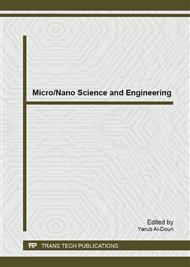[1]
Namkoong, Gon Kong, Jaemin Samson, Matthew Hwang, In-Wook Lee, Kwanghee, Active layer thickness effect on the recombination process of PCDTBT: PC71BM organic solar cells. Organic Electronics, 2013. 14(1): pp.74-79.
DOI: 10.1016/j.orgel.2012.10.025
Google Scholar
[2]
Ratcliff, Erin L. Meyer, Jens Steirer, K. Xerxes Armstrong, Neal R. Olson, Dana Kahn, Antoine, Energy level alignment in PCDTBT: PC70BM solar cells: Solution processed NiOx for improved hole collection and efficiency. Organic Electronics, 2012. 13(5): pp.744-749.
DOI: 10.1016/j.orgel.2012.01.022
Google Scholar
[3]
Gholamkhass, Bobak Servati, Peyman, Solvent–vapor induced morphology reconstruction for efficient PCDTBT based polymer solar cells. Organic Electronics, 2013. 14(9): pp.2278-2283.
DOI: 10.1016/j.orgel.2013.05.014
Google Scholar
[4]
Jørgensen, Mikkel Norrman, Kion Krebs, Frederik C., Stability/degradation of polymer solar cells. Solar Energy Materials and Solar Cells, 2008. 92(7): pp.686-714.
DOI: 10.1016/j.solmat.2008.01.005
Google Scholar
[5]
Glatthaar, M. Niggemann, M. Zimmermann, B. Lewer, P. Riede, M. Hinsch, A. Luther, J., Organic solar cells using inverted layer sequence. Thin Solid Films, 2005. 491(1–2): pp.298-300.
DOI: 10.1016/j.tsf.2005.06.006
Google Scholar
[6]
Sekine, N. Chou, C. H. Kwan, W. L. Yang, Y., ZnO nano-ridge structure and its application in inverted polymer solar cell. Organic Electronics: physics, materials, applications, 2009. 10(8): pp.1473-1477.
DOI: 10.1016/j.orgel.2009.08.011
Google Scholar
[7]
Rana Bekci, D. Karsli, Adem Cagatay Cakir, A. Sarica, Hizir Guloglu, Alper Gunes, Serap Erten-Ela, Sule, Comparison of ZnO interlayers in inverted bulk heterojunction solar cells. Applied Energy, 2012. 96(0): pp.417-421.
DOI: 10.1016/j.apenergy.2012.02.077
Google Scholar
[8]
Liang, Zhiqiang Zhang, Qifeng Wiranwetchayan, Orawan Xi, Junting Yang, Zhou Park, Kwangsuk Li, Chundong Cao, Guozhong, Effects of the Morphology of a ZnO Buffer Layer on the Photovoltaic Performance of Inverted Polymer Solar Cells. Advanced Functional Materials, 2012. 22(10): pp.2194-2201.
DOI: 10.1002/adfm.201101915
Google Scholar
[9]
Ismail, Yasser A. M. Soga, T. Jimbo, T., Improvement in light harvesting and performance of P3HT: PCBM solar cell by using 9, 10-diphenylanthracene. Solar Energy Materials and Solar Cells, 2009. 93(9): pp.1582-1586.
DOI: 10.1016/j.solmat.2009.04.012
Google Scholar
[10]
Hau, Steven K. Yip, Hin-Lap Jen, Alex K. Y., A Review on the Development of the Inverted Polymer Solar Cell Architecture. Polymer Reviews, 2010. 50(4): pp.474-510.
DOI: 10.1080/15583724.2010.515764
Google Scholar



